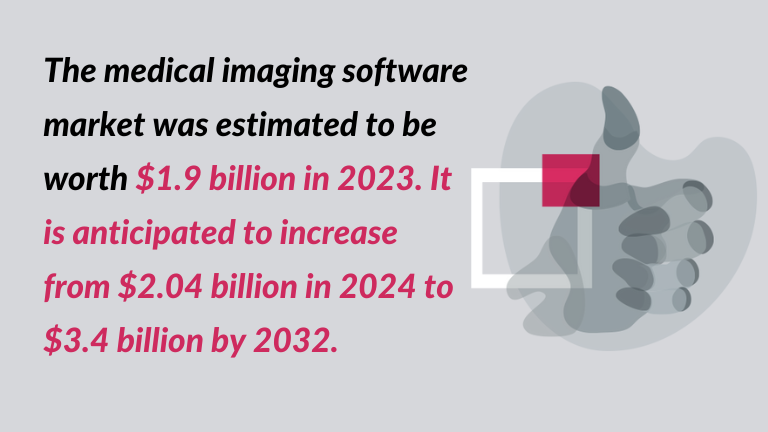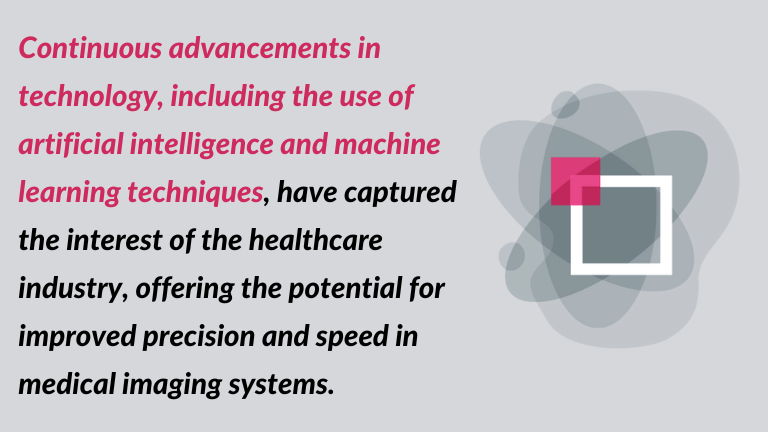Medical imaging software market analysis: trends and future opportunities
The medical imaging software market was estimated to be worth $1.9 billion in 2023, according to the most recent analysis available, published in July 2024. From $2.04 billion in 2024 to $3.4 billion by 2032, it is anticipated to increase, exhibiting a compound annual growth rate (CAGR) of 6.56% throughout the projection period (2024-2032).
Additionally, high productivity technology and advancements in medical technology are the main drivers of the growth. [1]
Let’s glimpse into the future and examine how the field of medical imaging software development is evolving.
Medical imaging software development market
The data mentioned above indicates that the medical imaging software development industry is expected to experience gradual growth in the coming years. What are the contributing factors? Certainly, these are innovative technologies.

The demand for non-invasive diagnostic methods is increasing
The growth of the medical imaging software development market is driven by the increasing demand for non-invasive diagnostic techniques. Certainly, this type of software enables non-invasive diagnosis of a wide range of medical disorders, leading to increased demand for these technologies. Non-invasive diagnostic techniques are preferred over invasive treatments due to being less uncomfortable, having fewer consequences, and requiring less recovery time. [2]
Support for the diagnosis of chronic diseases
The growing prevalence of chronic diseases like cancer and cardiovascular disorders is another factor propelling the expansion of the medical imaging software development market. This software plays a crucial role in identifying, diagnosing, and planning treatment for various disorders. Additionally, the increasing elderly population, who are more susceptible to cardiovascular disease or neurodegenerative disease, is also contributing to the rising demand for medical imaging software. [3]
AI and ML in the medical imaging software development market
Continuous advancements in technology, including the use of artificial intelligence and machine learning techniques, have captured the interest of the healthcare industry, offering the potential for improved precision and speed in medical imaging systems.
As a result, demand for the development of medical imaging software based on artificial intelligence has increased. Vendors are providing customers with personalized advanced solutions that enable them to perform tasks that were previously impossible. Artificial intelligence systems, for example, can analyze medical images to detect abnormalities that radiologists may have overlooked. Increased precision in diagnosis and treatment planning translates into better patient outcomes. [4]
As I have noted, AI’s adoption in medical imaging has constantly transformed market trends in recent years. The future of this looks very bright.

Cloud-based technologies
One major factor fueling the expansion of the medical imaging software development market is the availability of cloud-based imaging solutions.
Moreover, cloud-based technology has made it possible for medical practitioners to access medical pictures at any time and from any location. It has improved patient care and fostered greater teamwork.
Growing demand for new technologies in medicine
As indicated in the report cited in my article, the market for the development of medical imaging devices is continuously growing. In effect, modern technologies firmly establishing themselves in the medical industry.
Surely, integrating AI, cloud computing, and advanced imaging techniques will continue transforming the market, improving diagnostic accuracy and patient outcomes.
Resources
[1, [3], [4] https://www.marketresearchfuture.com/reports/medical-imaging-software-market-7622
[2] Medical Imaging Software Market Size Source: https://www.mordorintelligence.com/industry-reports/medical-imaging-software-market-industry/market-size